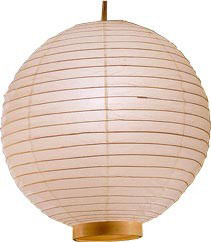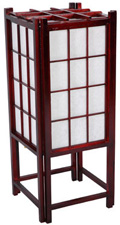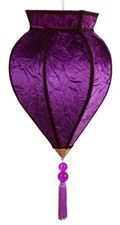Does Color Matter when Buying an Asian Lantern?
Asian rice paper lanterns have a rich history extending over hundreds of centuries, and every color and shape is linked to religious and cultural tradition. While these are beautiful decorations which fit wonderfully into any home from China to Japan to Europe to America, a richer appreciation of these lovely furnishings can be gained by examining their past and present. Let’s begin!
Rice Paper Material
 The earliest known reference to rice paper exists in writings dating back to the Tang Dynasty in China (618-907 AD). It was initially manufactured out of rice straw, but as with many other Chinese traditions, rice paper traveled throughout Asia and was modified by each culture it encountered. Modern rice paper differs in “recipe” from one country to another—some lanterns are still made of rice straw, some of mulberry, some of bamboo, some of combinations thereof, or other less common plants.
The earliest known reference to rice paper exists in writings dating back to the Tang Dynasty in China (618-907 AD). It was initially manufactured out of rice straw, but as with many other Chinese traditions, rice paper traveled throughout Asia and was modified by each culture it encountered. Modern rice paper differs in “recipe” from one country to another—some lanterns are still made of rice straw, some of mulberry, some of bamboo, some of combinations thereof, or other less common plants.
Despite the “recipe”, however, all rice paper shares a few elements: while rice paper crinkles readily, and crinkled rice paper is the main element in many lanterns and lamps, it can be crumpled and folded without damage, it is highly absorbent and sturdy, and it resists rot and mold.
Rice paper is widely used not only for lanterns but also for shoji screens (or room dividers) you can see many beautiful examples of the art of shoji elsewhere on our website.
Lanterns are typically held together by ribs of wire or bamboo, but other materials can be used as well. Also, modern lanterns are often made of fabric or other materials as well as rice paper; some lovely examples of this can be seen in our extensive lighting galleries.
Use Of Lanterns
 Rice paper lanterns are used for a multitude of purposes, from simple illumination, to everyday decoration, to very specific holiday and ceremonial duties. They are strongly tied with Buddhist tradition, and as such, different shapes and colors of lanterns, painted with a wide range of symbols, are linked with Buddhist practices and holidays.
Rice paper lanterns are used for a multitude of purposes, from simple illumination, to everyday decoration, to very specific holiday and ceremonial duties. They are strongly tied with Buddhist tradition, and as such, different shapes and colors of lanterns, painted with a wide range of symbols, are linked with Buddhist practices and holidays.
While the round lantern is used in multiple different countries and cultures, the Japanese do have a specific indigenous style of lanterns, which are short and rectangular in design, and feature wooden frames with translucent rice paper windows. These lanterns produce a soft ambient light best suited to quiet moods enhanced by subtle rather than bright lighting.
Red Lanterns
 Red is a very frequently used ceremonial color in China, because it is the color of good luck and abundance. Red is thought to ward off evil of all kinds, so nearly every positive event in Chinese family and religious life is marked with red decorations, red clothing, and of course, red lanterns! Births and marriages are particularly linked with red; wedding dresses are red, and red eggs are a traditional gift celebrating a new baby. The New Year is also lit with the vibrant red glow of thousands of red lanterns and wall-hangings, as well as the punctuating explosions of firecrackers, traditionally employed to ward off evil spirits. Your new red lantern will bring your family luck and joy, as well as serving as a lovely accent piece.
Red is a very frequently used ceremonial color in China, because it is the color of good luck and abundance. Red is thought to ward off evil of all kinds, so nearly every positive event in Chinese family and religious life is marked with red decorations, red clothing, and of course, red lanterns! Births and marriages are particularly linked with red; wedding dresses are red, and red eggs are a traditional gift celebrating a new baby. The New Year is also lit with the vibrant red glow of thousands of red lanterns and wall-hangings, as well as the punctuating explosions of firecrackers, traditionally employed to ward off evil spirits. Your new red lantern will bring your family luck and joy, as well as serving as a lovely accent piece.
Purple Lanterns
 In the practice of Feng Shui, purple signifies Yin (the female half of Yin/Yang), spiritual awareness, and both mental and physical healing. In China, a red so deep it is considered purple is highly auspicious, symbolizing good luck and fame. As such, a purple lantern can be an excellent focus for meditation and spiritual thought, and will bring you good fortune, as well as a beautiful subtle lighting effect.
In the practice of Feng Shui, purple signifies Yin (the female half of Yin/Yang), spiritual awareness, and both mental and physical healing. In China, a red so deep it is considered purple is highly auspicious, symbolizing good luck and fame. As such, a purple lantern can be an excellent focus for meditation and spiritual thought, and will bring you good fortune, as well as a beautiful subtle lighting effect.
Yellow Lanterns
 Yellow is another richly significant color in Asian culture. In China, it is a nourishing, sacred, and imperial color, linked with the color of the earth and the color of skin. In Buddhism, it is linked to wisdom; in Japan, it connotes courage. A yellow lantern throws a gentle golden glow which fits into a wide range of indoor color schemes, and is greatly comforting.
Yellow is another richly significant color in Asian culture. In China, it is a nourishing, sacred, and imperial color, linked with the color of the earth and the color of skin. In Buddhism, it is linked to wisdom; in Japan, it connotes courage. A yellow lantern throws a gentle golden glow which fits into a wide range of indoor color schemes, and is greatly comforting.
White Lanterns
 While white is the color of mourning in both China and Japan, in Korea, it is a highly sacred and much-used color. It is linked with the Buddhist idea “come empty, return empty”, and thus is related both to birth and to death. It also connotes purity, innocence, and morality. A white lantern matches nearly any other item in your home, and produces a pure, bright light for you and your family to enjoy.
While white is the color of mourning in both China and Japan, in Korea, it is a highly sacred and much-used color. It is linked with the Buddhist idea “come empty, return empty”, and thus is related both to birth and to death. It also connotes purity, innocence, and morality. A white lantern matches nearly any other item in your home, and produces a pure, bright light for you and your family to enjoy.
Green Lanterns
 In many cultures all over the world, green is associated with nature and growing things, and this holds true in the tradition of Feng Shui, where green represents the feminine Yin, as well as wood, harmony, health, and growth. A slightly more hair-raising connotation comes from China, where green is the color of exorcism! A green lantern promotes an excellent atmosphere for study and spiritual growth.
In many cultures all over the world, green is associated with nature and growing things, and this holds true in the tradition of Feng Shui, where green represents the feminine Yin, as well as wood, harmony, health, and growth. A slightly more hair-raising connotation comes from China, where green is the color of exorcism! A green lantern promotes an excellent atmosphere for study and spiritual growth.
Blue Lanterns
 In China, blue is a feminine color, representing Yin, and more specifically often used for little girls, in a reversal of the European/American blue/pink. In Feng Shui, it also carries the more familiar meanings of water, peace, and relaxation. A blue lantern creates a restful atmosphere.
In China, blue is a feminine color, representing Yin, and more specifically often used for little girls, in a reversal of the European/American blue/pink. In Feng Shui, it also carries the more familiar meanings of water, peace, and relaxation. A blue lantern creates a restful atmosphere.

